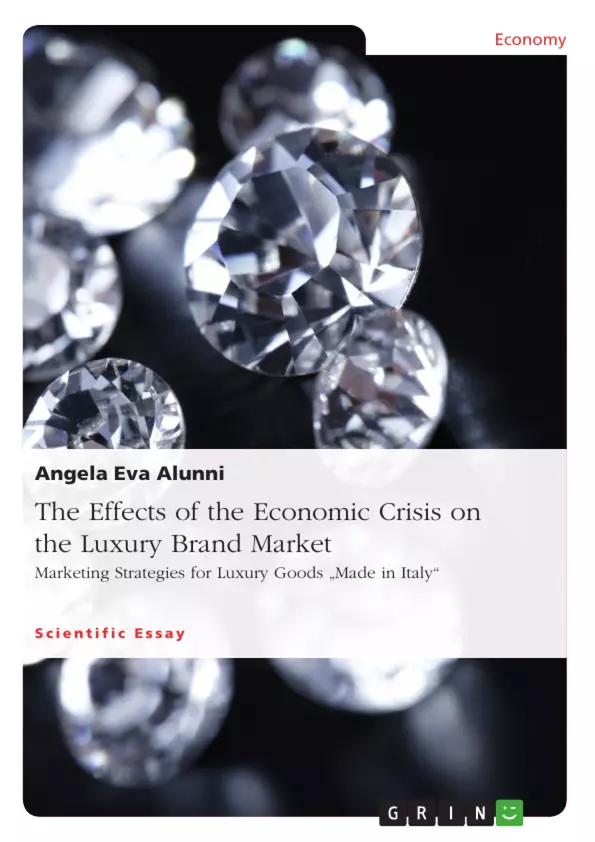Luxury represents a product category that seemingly was able to weather the storm of financial and economic crisis hitting global markets in 2008 better than could be expected. In this scientific essay, the author Angela Alunni credits two main factors for this trend: Successful luxury companies cater to the emerging markets of the nouveau riches, which are at the center of nurturing the demand for these goods. Internationalization provides the financial and managerial framework for these Italian companies, while not betraying the essence of the luxury concept per se. The portrayal of the Bulgari case highlights these strategies and at the same time points to the challenges that the luxury industry Made in Italy has to face as a whole.
Inhaltsverzeichnis (Table of Contents)
- CHAPTER ONE
- THE MARKET OF LUXURY GOODS: GENERAL CHARACTERISTICS
- The concept of luxury
- The supply and demand of luxury goods
- Luxury and Made in Italy
- CHAPTER TWO
- THE DIVIDE OF SEPTEMBER 2008
- The market of luxury goods during the crisis years
- The trend of Italian companies in the luxury goods industry
- Beyond the crisis: new markets and new strategies
- CHAPTER THREE
- THE BVLGARI CASE
- The areas of business: a changing environment
- The kickbacks of the international financial crisis
- Getting past the crisis: creativity, cost containment and the LVMH factor
Zielsetzung und Themenschwerpunkte (Objectives and Key Themes)
This project aims to understand the apparent resilience of Italian luxury brands during the 2008 financial crisis, particularly focusing on the case of Bvlgari. The project seeks to analyze the Bvlgari group's expansion during this period and its eventual absorption by LVMH. It also examines the broader dynamics of the luxury goods market, considering how this sector was impacted by the crisis and how brands adapted their strategies.
- The concept of luxury and its defining characteristics
- The impact of the 2008 financial crisis on the luxury industry
- The role of “Made in Italy” in the luxury goods market
- The case study of Bvlgari and its expansion during the crisis
- The strategies adopted by luxury brands to navigate the crisis
Zusammenfassung der Kapitel (Chapter Summaries)
- Chapter One: The Market of Luxury Goods: General Characteristics This chapter introduces the concept of luxury goods, examining the supply and demand dynamics within this market. It also explores the link between luxury and the “Made in Italy” label.
- Chapter Two: The Divide of September 2008 This chapter analyzes the impact of the 2008 financial crisis on the luxury goods market, particularly focusing on the performance of Italian companies in this sector. It also explores the strategies adopted by luxury brands to address the crisis.
- Chapter Three: The Bvlgari Case This chapter focuses on the case of Bvlgari, examining the company's history, its expansion during the crisis, and its eventual absorption by LVMH. It analyzes the factors contributing to Bvlgari's growth and its strategies for navigating the challenging economic climate.
Schlüsselwörter (Keywords)
This research focuses on the luxury goods market, the impact of the 2008 financial crisis, the role of “Made in Italy”, the Bvlgari case study, and the strategies adopted by luxury brands to navigate the crisis. It explores key concepts such as luxury goods, supply and demand, brand management, internationalization, and the impact of global economic events on specific industries.
- Quote paper
- Angela Eva Alunni (Author), 2014, The Effects of the Economic Crisis on the Luxury Brand Market, Munich, GRIN Verlag, https://www.grin.com/document/299352



